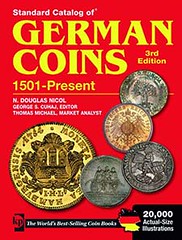
PREV ARTICLE
NEXT ARTICLE
FULL ISSUE
PREV FULL ISSUE
BOOK REVIEW: STANDARD CATALOG OF GERMAN COINS
A lengthy review of the latest edition of Krause Publications' Standard Catalog of German Coins by Karsten Dahmen was published in the August 11, 2011 issue of CoinsWeekly. Here are some excerpts.
-Editor
This volume of Krause Publication's series of catalogues deals with the coinage of Germany and German states from the beginning of the 16th century to the present (earlier editions commenced with the year 1601). The period covered hence ranges from the creation of a huge silver coin as equivalent to the (gold) Gulden, that is from the advent of the Taler and its wide usage during the 16th and 17th centuries, to the downfall of the Empire at hands of Napoleon's armies in 1806; the various monetary unions among German states (and Austria) in the 19th century to the creation of a united Germany in 1871; the catastrophes of WW I and II and the separation into two German states along the borders of the Iron Curtain; and finally, the fortunate unification of East and West Germany in 1990, followed by the inauguration of the Euro in 2002. Although, after 1871, the identification of a coin and its issuing authority as ‘German' will represent no problem, the contrary holds true for earlier times. As the Holy Roman Empire included territories which today belong to France, Belgium, the Netherlands, Switzerland, Poland and others, the decision to include or exclude a certain issue is always delicate and will follow a rather pragmatic approach: hence, while those of present-day Austria are excluded (minted under the authority of the Habsburg emperors), those from German dominated Silesia, which became a part of Prussia only in 1740 when taken from the Austrians, are included; as are coins from Alsace-Lorraine, which fell under French domination at the end of the 17th century and only from 1871-1918 was part of the German Empire. The second main obstacle to cataloguing and identifying all issues in question is a rather simple one: because of the high number of minting authorities involved, the state of numismatic research into these coins is similarly diverse. Some have recently and satisfyingly been covered by modern research, while for others we still lack up-to-date coin catalogues and mint histories which would provide essential information on mintage numbers, mintmasters, monograms and mintmarks, respectively. Base metal coins and fractions (in contrast to the more precious Taler and gold coins, ducats and gulden) in particular are mostly unpublished yet and await their renewed appreciation in private and museum collections. The creation of such a ‘Standard Catalog' from a German perspective, therefore, represents a somewhat daring, but laudable, enterprise, which allows for a number of unanswered questions and imponderability cleared away only with each subsequent edition, much in contrast to the psychology of the German numismatic community and scholarly mind. This is why it comes as no surprise to the reviewer that this catalogue covering 500 years of German coinage was produced in the US rather than in Germany (comparable collectors' guides in German go back in time only as far as 1700). It is beyond doubt that this ‘Standard Catalog' strongly benefits from N. Douglas Nicol's access to German numismatic research and publications in the field. Coins are listed chronologically beginning with the lowest denomination. Mintages are given where available; prices are provided in five grades, though with mintage numbers in most cases lacking, no differentiation for individual annual issues can be provided. In accordance with the series, KM# denotes database numbers (searchable on the Krause website), not subsequent and self-explanatory catalogue numbers within each entity. Being a compilation of known (and published) types combined with valuations, this 3rd edition of the ‘Standard Catalog of German Coins 1501 to Present' constitutes an extremely helpful and appreciable tool for anybody collecting and handling German coins or dealing in German numismatics. Besides being the only existing reference of this kind so far (compare the reasons mentioned above), it provides the first and most elementary step into the appreciation of the subject.
To read the complete article, see:
"A daring enterprise": the ‘Standard Catalog of German Coins' in a New Edition
(www.coinsweekly.com/en/News/4?&id=730)
The Numismatic Bibliomania Society is a non-profit organization promoting numismatic literature. See our web site at coinbooks.org. To submit items for publication in The E-Sylum, write to the Editor at this address: whomren@gmail.com To subscribe go to: https://my.binhost.com/lists/listinfo/esylum All Rights Reserved. NBS Home Page Contact the NBS webmaster 
|
